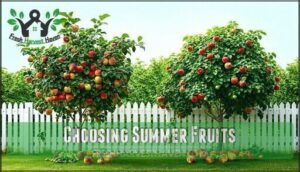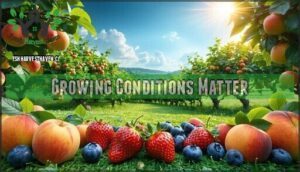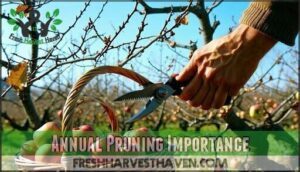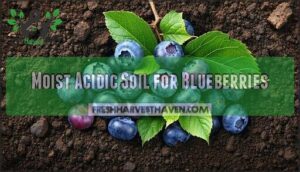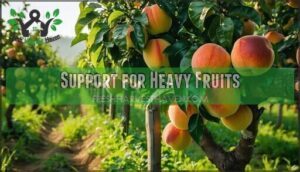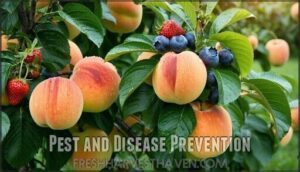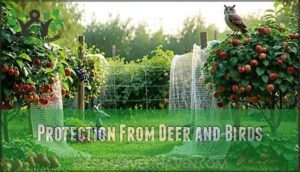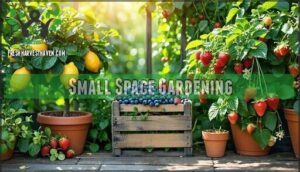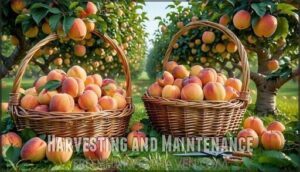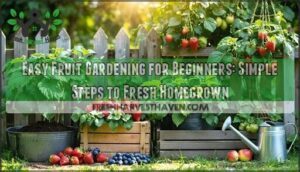This site is supported by our readers. We may earn a commission, at no cost to you, if you purchase through links.

Start with easy options like strawberries, blueberries, or dwarf fruit trees that thrive in containers.
Most summer fruits need full sun and well-draining soil to flourish. Strawberries produce quick results, while blueberries require acidic soil but reward you for years.
Container growing works perfectly for small spaces – just choose dwarf varieties and provide consistent watering. Regular pruning keeps trees healthy and productive.
The secret lies in matching your chosen fruits to your specific growing conditions and available space, using the right summer fruits and providing consistent watering.
Table Of Contents
- Key Takeaways
- Choosing Summer Fruits
- Growing Conditions Matter
- Fruit Tree Care Tips
- Small Space Gardening
- Harvesting and Maintenance
- Frequently Asked Questions (FAQs)
- What is the easiest fruit to grow in the summer?
- What fruit is best to grow in summer?
- What is the easiest fruit to grow yourself?
- What fruit grows during the summer?
- What fruits do you plant in the summer?
- What fruit grows best in hot weather?
- What is the easiest fruit tree to grow at home?
- How to start growing fruits from seeds?
- Can summer fruits thrive in partial shade?
- What fertilizers are best for summer fruits?
- Conclusion
Key Takeaways
- Start with beginner-friendly options – You’ll have success with strawberries for quick results, blueberries for long-term harvests, and dwarf fruit trees that fit in containers
- Match plants to your space and conditions – Choose dwarf varieties for small areas, ensure full sun exposure, and provide well-draining soil for optimal growth
- Container growing works anywhere – You can grow summer fruits on patios or balconies using 20+ gallon containers with proper drainage and quality potting mix
- Consistent care ensures abundant harvests – You’ll need regular watering, annual pruning, and pest protection to maintain healthy plants that produce for years
Choosing Summer Fruits
You’ll want to start with proven varieties that match your growing conditions and space limitations.
Popular choices like Honeycrisp apples, Redhaven peaches, and Triple Crown blackberries offer reliable harvests with manageable care requirements.
Popular Apple Tree Varieties
Apple trees offer some of the best summer fruits for home gardening. You’ll want Cold-Hardy Apples like Honeycrisp for exceptional sweetness and crunch. Red Delicious dominates commercial production, while Granny Smith brings perfect tartness for baking.
Most Apple trees need cross-pollination, so plant two varieties for a Heavy Apple Harvest. For warmer climates, consider planting Anna apple varieties.
- Dwarf Apple Trees fit small spaces, growing 7-10 feet tall
- Easy-Grow Apples like Gala require minimal maintenance once established
- Apple Pollination Needs mean planting compatible fruit varieties together
Harvest season runs late August through November for fresh eating
Popular Pear Tree Varieties
Pear trees offer excellent variety for home gardeners seeking disease resistance and reliable harvests.
Asian pears provide crisp, apple-like texture, while Bartlett delivers classic flavor perfect for canning.
Consider pear rootstocks carefully – dwarf varieties work well for espalier pears in tight spaces.
Most varieties need pear pollination partners, so plant two different types nearby.
Summer fruits like early pears ripen first, extending your harvest season through fall with proper variety selection.
For those in colder climates, Baldwin pear trees are a hardy choice.
Popular Plum Tree Varieties
When selecting plum trees for your garden, you’ll find exciting variety options.
Japanese plums like Santa Rosa produce large, sweet-tart fruits perfect for fresh eating.
European varieties such as Stanley and Damson offer smaller, tarter plums ideal for preserves and cooking.
Consider these top choices for summer fruits:
- Santa Rosa – Fast-growing Japanese variety with large, flavorful plums
- Stanley – European type with firm flesh and excellent storage qualities
- Methley – Early-ripening variety that extends your harvest season
Most plum trees require cross-pollination between different varieties for fruit production.
Proper pruning plums annually maintains tree health and maximizes yields.
Choose disease-resistant plum rootstock to minimize common plum diseases and plum pests that affect growing stone fruits.
Popular Peach Tree Varieties
Which peach cultivars deliver the best summer fruit trees for your garden? Choose varieties that match your growing regions and climate needs.
- Redhaven: Early ripening with high disease resistance, perfect for colder climates and fresh eating
- Elberta: Mid-late summer harvest, vigorous growth, ideal for warmer zones and canning
- Cresthaven: Late season variety with excellent disease resistance across diverse climate ranges
- Belle of Georgia: Mid-summer white peach, best for temperate regions and fresh consumption
Proper pruning techniques boost fruit qualities and tree health substantially.
Growing Conditions Matter
Your summer fruit garden’s success depends entirely on getting the growing conditions right from the start.
Success starts with soil, sun, and smart variety choices for your backyard bounty.
Most fruit trees and berry bushes need full sun, well-draining soil, and proper care to produce those sweet, juicy harvests you’re craving.
They require these conditions to thrive and produce a bountiful harvest.
Full Sun Requirements
Most fruit trees need full sunlight for ideal growth.
Your plants require six to eight hours of direct sun daily.
This sunlight duration maximizes photosynthesis efficiency and promotes proper fruit ripening.
Leaf orientation naturally adjusts to capture maximum light.
Varietal differences affect sun tolerance, but full sunlight remains ideal.
Without adequate sun exposure, fruit production suffers substantially.
Choose locations with consistent morning-to-afternoon light.
Well-Draining Soil Needs
Successful fruit growing starts with proper soil composition. You’ll need well-draining soil to prevent root rot, which kills more fruit trees than drought.
Test drainage by digging a hole and filling it with water—it should drain within hours. Improve heavy clay with soil amendments like compost or coarse sand.
Raised beds offer excellent drainage methods for challenging soil conditions.
Annual Pruning Importance
Annual pruning transforms your summer fruits into productive powerhouses.
You’ll boost fruit yield by removing dead, diseased, and crossing branches that block sunlight and airflow. Sharp pruning tools make clean cuts that heal quickly, preventing disease entry.
Winter dormancy offers the perfect timing for most fruit tree pruning techniques. This essential fruit tree maintenance shapes growth patterns and maximizes tree health for years ahead.
To avoid fungal diseases, proper pruning also increases critical airflow.
Moist Acidic Soil for Blueberries
When you’re growing blueberries, soil pH between 4.5-5.5 creates the perfect acidic soil environment.
Drainage importance can’t be overstated—waterlogged roots spell disaster. Mix organic amendments like peat moss into your soil.
Master proper watering techniques by keeping soil consistently moist but never soggy. With proper blueberry nutrition and soil requirements, your fruit plant care routine becomes simple yet effective for thriving blueberries.
Fruit Tree Care Tips
Once your fruit trees are established, proper care guarantees healthy growth and abundant harvests.
You’ll need to maintain consistent watering schedules, provide support for heavy branches, and protect your investment from common threats to ensure abundant harvests.
Watering Frequency
Water management makes or breaks your summer fruit success. Too much creates soggy roots and rot, while too little leaves you with shriveled, disappointing harvests.
Check soil moisture before reaching for the hose. Your finger works fine—stick it two inches deep. Dry soil needs water, damp soil can wait.
Create your watering schedule based on these factors:
- Weather patterns – Hot, windy days demand more frequent watering
- Soil type – Sandy soil drains faster than clay
- Container size – Smaller pots dry out quicker
- Plant maturity – Established trees need less frequent, deeper watering.
Optimal hydration keeps your home fruit gardening thriving without waterlogged disasters.
Support for Heavy Fruits
Heavy fruit can snap branches without proper support.
You’ll need trellis systems or bracing to handle weight distribution effectively. Staking works well for younger trees, while caging supports mature branches.
Branch reinforcement prevents costly damage during peak season. For ideal growth, explore different fruit tree supports.
Consider fruit thinning early to reduce load. Harvesting aids like picking poles help reach supported fruit safely.
Smart trellis design keeps your trees productive year after year.
Pest and Disease Prevention
Protecting your fruit trees isn’t rocket science. Stay ahead of pests and diseases by choosing disease-resistant varieties and practicing preventative pruning. Organic pesticides like neem oil work wonders against aphids and mites.
Companion planting with herbs repels unwanted visitors while boosting soil health. You can find more options for resistant plant products online.
- Regular monitoring catches problems early
- Remove fallen leaves and debris to prevent overwintering pests
- Apply dormant oil sprays during winter for organic pest control
Protection From Deer and Birds
Beyond traditional fencing, smart repellent options and scare tactics protect your summer fruits effectively.
Netting effectiveness increases when combined with motion-activated sprinklers. Natural predators like owls deter birds naturally.
| Protection Method | Best For | Effectiveness |
|---|---|---|
| Bird netting | Small fruits | High |
| Fencing solutions | Deer control | Very high |
| Reflective tape | Bird deterrent | Medium |
| Scent sprays | Deer repelling | Medium |
Strategic fruit tree care includes rotating deterrent methods. Pests adapt quickly, so change tactics regularly for sustained fruit gardening success.
Small Space Gardening
You don’t need acres to grow delicious summer fruits – containers and small spaces work perfectly for many varieties.
Dwarf fruit trees, berry bushes, and compact plants let you enjoy fresh harvests even in tiny yards or on patios.
Container Gardening Options
Container gardening makes growing summer fruits possible anywhere. You’ll need proper container size and drainage for healthy roots. Dwarf varieties work best for patio gardening since they stay compact.
Consider browsing specialized dwarf tree retailers for more options.
- Choose containers at least 20 gallons for fruit trees
- Use quality potting mixes with good drainage
- Position containers for maximum sunlight exposure
Vertical growth options like columnar apple trees maximize space. Many dwarf varieties enable indoor fruiting with adequate light. Container fruit gardening lets you control soil conditions perfectly.
Suitable Fruit Varieties for Small Spaces
Small space fruit growing doesn’t require huge yards.
Dwarf fruit trees and vertical fruit options work perfectly for patios and balconies.
Container-friendly fruits like dwarf apple varieties grow 8-10 feet tall while columnar types stay under 4 feet wide.
Espalier fruit trees train against walls, maximizing space.
Your patio fruit selection can include dwarf peach, plum, and citrus varieties.
Container fruit gardening succeeds with proper pot sizes and placement.
These dwarf varieties produce full-sized fruit in compact spaces.
Consider espaliered fruit trees to maximize sunlight exposure and yield, using espaliered fruit trees for optimal results.
Raspberry Bush Support
Since raspberries produce long, flexible cane support that can bend under fruit weight, you’ll need sturdy trellis systems to keep them upright.
Install posts with horizontal wires or use DIY supports like bamboo stakes.
Proper trellis support makes harvesting easier and prevents canes from sprawling.
Pruning impact varies by variety—some need annual cane removal while others benefit from selective trimming for better air circulation.
Blueberry Planting in Pots
Growing blueberries in containers pays off when you nail the basics.
These summer fruits need proper setup for backyard fruit growing success.
- Container size matters: Choose 18-24 inch pots for healthy root development
- Potting mix selection: Use acidic soil designed for container gardening
- Variety selection: Pick compact cultivars suited for pots
Watering needs stay consistent—keep soil moist but not waterlogged.
Winter protection becomes essential in colder climates.
Follow these fruit growing tips for thriving blueberry harvests.
Harvesting and Maintenance
You’ll know it’s harvest time when your fruits reach peak ripeness, which varies from late summer through fall depending on the variety.
Most fruit trees and berry bushes will produce for many years with proper care, though you’ll need to replace strawberry plants every few years to maintain good yields.
Peak Harvest Seasons
Fresh harvests depend on recognizing ripening signs and perfect harvest timing. Summer fruits mature at different intervals throughout the season. Seasonal yields peak when you catch each variety at its prime moment.
| Fruit | Peak Harvest Season |
|---|---|
| Strawberries | June-August |
| Peaches | July-September |
| Apples | August-November |
| Blackberries | July-August |
| Blueberries | June-August |
Watch for color changes and easy stem separation to identify readiness. Plan appropriate storage methods for extending season enjoyment of your summer harvest.
Fruit Production Timeline
After peak harvest seasons pass, you’ll want to understand fruit development timelines.
Most summer fruits won’t produce in their fruiting first year, so patience pays off during these maturity milestones:
- Fig trees: 1-2 years for first harvest windows
- Peach trees: 2-4 years with seasonal variations in ripening stages
- Apple trees: 2-5 years for initial fruit production
- Cherry trees: 4-7 years before harvest times begin
- Pear trees: 4-6 years for fruit ripening to start
Understanding fruit harvest timing is vital for maximum yields.
Plant Longevity and Replacement
Your fruit trees won’t last forever, but understanding tree lifespan helps you plan ahead.
Most fruit trees produce for 15-30 years, though rootstock influence and disease resistance affect longevity.
Watch for declining yields or increased fruit tree diseases – signs it’s replacement timing.
Soil depletion weakens trees over time, making them vulnerable to fruit tree pests.
Choose fruit tree varieties with strong pest resistance for your next planting.
Start new trees before old ones fail completely.
General Gardening Tips for Success
Success starts with soil preparation—clear weeds and enrich dirt before planting your summer fruits.
Master weed control through mulching and regular monitoring. Keep tool maintenance simple by cleaning equipment after each use.
Factor in climate considerations when choosing varieties for your fruit gardening guide. Make seasonal adjustments by protecting plants during temperature swings.
These gardening tips guarantee your summer gardening efforts pay off with abundant harvests year after year.
Frequently Asked Questions (FAQs)
What is the easiest fruit to grow in the summer?
Tomatoes top the list as summer’s easiest fruit to grow. You’ll enjoy container-friendly varieties, minimal care requirements, and abundant harvests from these beginner-friendly plants that thrive in heat.
What fruit is best to grow in summer?
Like planting seeds in fertile ground, you’ll find tomatoes are your best bet for summer growing. They’re beginner-friendly, thrive in heat, and produce abundant harvests with minimal care required.
What is the easiest fruit to grow yourself?
Strawberries top the list for beginner gardeners. They’re self-fertile, grow in containers or beds, spread naturally through runners, and produce fruit quickly with minimal care required.
What fruit grows during the summer?
Before GPS guided your harvest, you’d need to master timing.
Berries like strawberries, raspberries, and blueberries ripen throughout summer months.
Melons, tomatoes, and stone fruits like peaches also thrive in warm weather conditions.
What fruits do you plant in the summer?
You’ll plant warm-season fruits in summer: melons, watermelons, and late-season strawberries. Summer’s also perfect for transplanting citrus trees and establishing berry bushes for next year’s harvest.
What fruit grows best in hot weather?
While delicate berries wilt, heat-loving fruits thrive in scorching temperatures.
You’ll find peaches, melons, and figs flourish when mercury rises.
These sun-worshippers actually perform better in hotter, humid conditions than their cool-weather cousins, and they are true heat-lovers.
What is the easiest fruit tree to grow at home?
Apple trees are your best bet for beginner-friendly fruit growing. They’re incredibly adaptable to different climates and soil conditions, making them nearly foolproof for home gardeners starting out.
How to start growing fruits from seeds?
Before smartphones tracked our every step, you’d collect seeds from ripe fruits you’ve enjoyed.
Clean them thoroughly, removing all pulp.
Stratify seeds in damp sand for weeks in your refrigerator.
Plant in quality potting mix, keeping soil consistently moist but not waterlogged for germination.
Can summer fruits thrive in partial shade?
Most summer fruits prefer full sun, but you’ll find success with partial shade for berries like blueberries, blackberries, and raspberries.
They’ll still produce fruit, though yields may be lower than sunny spots, which is a complete concept to consider when planting.
What fertilizers are best for summer fruits?
You’ll want balanced fertilizers with equal nitrogen, phosphorus, and potassium ratios. Compost works great for organic options. Apply slow-release granules in spring, then liquid fertilizer monthly during growing season.
Conclusion
Successfully growing summer fruits at home transforms your backyard into a telegraph of fresh flavors.
You’ll enjoy strawberries within months, while blueberries and dwarf trees reward patience with years of harvests.
Container growing works perfectly for apartments and small yards. Choose varieties suited to your climate and space.
Provide full sun, proper drainage, and consistent care. Regular pruning keeps plants healthy and productive.
With proper planning, you’ll grow summer fruits at home that beat any store-bought produce, enjoying the fresh flavors and full sun in your backyard.

